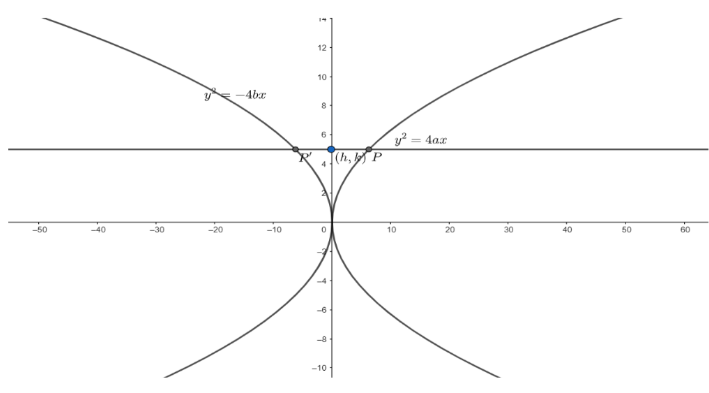Question
Question: Two parabolas have a common axis and concavities in opposite directions. If any line parallel to the...
Two parabolas have a common axis and concavities in opposite directions. If any line parallel to the common axis meets the parabolas in and , prove that the locus of midpoint of is another parabola, provided that the latera recta of the given parabola are unequal.
Solution
Hint: Equation of line parallel to the common axis is given by y=c.
Let’s consider the two parabolas y2=4ax and y2=−4bx.
From the equation of the parabola, we can see that the axis of the parabolas is common and their concavities are opposite.

Now, we know the equation of the common axis is y=0.
So, the equation of a line parallel to the common axis is y=c.
Now, this line meets the parabolas y2=4ax and y2=−4bx at P and P′ respectively.
Let the midpoint of PP′ be (h,k)....(i).
Now, substituting y=c in y2=4ax, we get:
c2=4ax
⇒x=4ac2
So, the point P is (4ac2,c).
Substituting y=c in y=−4bx, we get:
c2=−4ax
⇒x=4b−c2
So, the coordinates of P′ are (4b−c2,c).
Now, know that the coordinates of the midpoint of the line joining two points (x1,y1) and (x2,y2) is given as:(2x1+x2,2y1+y2)
So, the midpoint of PP′ is
24ac2−4bc2,2c+c
=(8ac2−8bc2,c)....(ii)
From (i)and (ii), we can conclude that
h=8ac2−8bc2 and k=c
Or, h=8ak2−8bk2
Or, h=8k2(a1−b1)
Or, h=8k2(abb−a)
Or, a−b8h(ab)=k2
Or k2=b−a8ab.h
Or k2=4(b−a2ab).h
Replacing k by yand h by x, we get:
y2=4(b−a2ab).x
which clearly represents a parabola.
Hence, the locus of the midpoint of PP′ is the parabola y2=4(b−a2ab).x.
Now, in case if the latera recta of the parabolas are equal then:
We know, length of latus rectum of parabola y2=4ax is 4a and the length of latus rectum of parabola y2=−4bx is 4b.
If the latera recta are equal, then
4a=4b
⇒a=b
⇒b−a=0
Now, when we substitute b−a=0 in the equation of locus, we get
y2=4(02ab).x
⇒y2=∞ which is an invalid curve.
Hence, for the locus to exist, the latera recta of the two parabolas must be unequal.
So, the locus of PP′is a parabola , given by y2=4(b−a2ab).x, which exists only when the latera recta of the given two parabolas are unequal.
Note: Remember that the midpoint of two points (x1,y1) and (x2,y2)is given as (2x1+x2,2y1+y2). Students generally make a mistake of writing it as (2x1−x2,2y1−y2).
